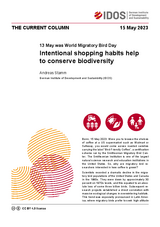13 May was World Migratory Bird Day
Intentional shopping habits help to conserve biodiversity
Stamm, AndreasThe Current Column (2023)
Bonn: German Institute of Development and Sustainability (IDOS), The Current Column of 15 May 2023
Bonn, 15 May 2023. Were you to browse the shelves of coffee at a US supermarket such as Walmart or Safeway, you would come across roasted varieties carrying the label “Bird-Friendly Coffee”, a certification scheme run by the Smithsonian Migratory Bird Center. The Smithsonian Institution is one of the largest natural science research and education institutions in the United States. So, why are migratory bird researchers interested in how coffee is grown?
Scientists recorded a dramatic decline in the migratory bird populations of the United States and Canada in the 1990s. They were down by approximately 30 percent on 1970s levels, and this equated to an absolute loss of some three billion birds. Subsequent research projects established a direct correlation with massive ecological changes in overwintering habitats. This trend was especially pronounced in Latin America, where migratory birds prefer to seek high-altitude spots to spend the winter, places where coffee farming represents the largest agricultural sector by far. Is coffee-growing detrimental to biodiversity conservation, then?
Not at all. Coffee is traditionally farmed in shade cultures and is just one of many crops cultivated on the agricultural land. When grown alongside other crops and shade trees, it offers farmers a reasonable income for the most part and provides a habitat for numerous insects and mammals, as well as the migratory birds that overwinter in the region.
So, what has changed? Why are many migratory birds failing to return to North America from Latin America? The Smithsonian Institution believes the transition in coffee farming from shade cultures to monocultures is a major factor. Growing coffee in unshaded areas allows per-hectare yields to be significantly increased, but leaves no room for crops that are not immediately productive. An intensively-managed farm in Colombia, for example, can grow up to 10,000 coffee plants per hectare, which equates to one plant per square metre. It is plausible that migratory birds may fail to find a suitable habitat in regions farmed in this way.
The basic idea of Bird-Friendly Coffee certification and the associated label is to encourage consumers to purchase coffee that is produced in shade cultures and thus strengthen the market position of biodiversity-friendly coffee producers. This has many beneficial effects in terms of sustainability:
Shade-grown coffee requires a far lower application of external agricultural chemicals. Many shade trees are legumes, fixing atmospheric nitrogen in their roots and returning it to the soil. This reduces the need to add nitrogen by other means, such as through the use of mineral fertilisers.
Shade-grown coffee also creates productive employment for more people than coffee grown in monocultures. For example, shade trees have to be planted and pruned. And if no mineral fertiliser is used whatsoever, then large quantities of organic fertiliser need to be produced and applied to the fields.
Additionally, cultivating coffee plants in the shade boosts the resilience of local agricultural systems, as production systems often see the coffee grown alongside not only legumes, but also crops important for farmers’ own food needs and/or for local markets, such as mangos, papayas and avocados.
Finally, growing coffee using traditional shade-cultivation strengthens the position of smallholder producers in the face of agro-capitalist companies seeking to minimise costs by intensifying production to the maximum possible extent and using machinery and agricultural chemistry.
The Smithsonian Institution has operated its Bird-Friendly Coffee certification programme since the late 1990s. Unfortunately, this programme has failed to stop the transition to monocultures. A 2014 study found that, while production volumes of shade-grown coffee have increased since 1996, the proportion of fields used for its cultivation globally has decreased from 43 percent to 24 percent.
What can consumers in Germany do about this? Though we cannot buy Bird-Friendly Coffee on the market in Germany, we should send a message through our purchasing decisions that we only wish to consume coffee that does not promote the transition to socially and environmentally undesirable monocultures. I always opt for Fairtrade coffee whenever I have the choice. The Fairtrade certification system was originally developed to protect smallholder producers from what are at times massive fluctuations in global market prices. Almost 800,000 smallholder coffee growers now benefit from this system. As the Fairtrade coffee standard has been developed further, it has placed an increasing focus on aspects of agroecology. Nonetheless, only when smallholders can be certain that the proceeds from the sale of their coffee will provide their families with a decent livelihood will they develop the peace of mind needed to actively pursue goals such as promoting biodiversity on their farms and protecting migratory birds.


